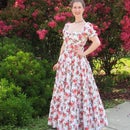Introduction: Lady in Red
Asymmetrical Hemmed Dress with Diamond Cutout & Attached Scarf
Step 1: Inspiration
Step 1: Find your inspiration! I always find it helpful to envision the finished product before any cutting or sewing is done. Even if the final product ends up looking nothing like your vision, it is helpful to have a preliminary idea of where you are heading.
My inspiration for this updated version of Vogue's 1948 design comes from a blend of Victoria Beckham piece from her Fall 2009 RTW collection as well as Roland Mouret's Copperfield gown.
Step 2: Fabric Layout & Cutting
Step 2: Lay out your pattern pieces to ensure that you have sufficient yardage. Cut out all pattern pieces.
Step 3: Back Skirt Seam & Godet
Step 3: Insert godet between lower half of two back skirt pieces. Lay the triangle shaped godet flat against one back skirt piece and stitch, followed by the other side. Then sew up the center back skirt seam.
Step 4:
Step 4: Finish the center back seam and godet by encasing your raw edges with rayon seam binding.
Step 5:
Step 5: Create a length of bias tubing with your fabric. Cut a length of fabric on the bias, fold in half (right sides together) and stitch. Trim the seam to a width that is just a smidge narrower than the loop. Using a loop turner, turn the tube right side out. Cut your bias tubing into equal lengths that will accommodate your buttons plus approximately ½”.
Step 6: Hand baste the raw edges of each bias tube end to end, forming a loop. Apply each loop at each button point, raw edges facing the raw edge of the bodice back. (It is okay if the raw edges do not reach the fabric edges – just make sure that those edges are within your seam allowance.)
Step 6:
Step 7: Right sides together, stich center back seam together below opening. Finish lower back edges with seam binding.
Step 8: Stitch the bottom edges of your back facing together. Finish the outside edges of the back facing.
Step 9: Right sides together, stitch back facing to back bodice along neck and back opening edges, making sure to catch the raw edges of your button loops within the seam allowance. Trim seam allowances and turn right side out. (If your facing is a different fabric from the dress or does not hold a crease well, you may want to under-stitch the seam allowance to the facing.)
Step 7:
Step 10: Edge-stitch the skirt back to bodice back. To do this, press under the seam allowance on the back skirt and lap this fold at the stitching line of the bodice back. Baste and stitch. Finish raw edge with seam binding, being careful not to catch the garment.
Step 8: Narrow Hem Raw Edges
Step 11: Hand roll a narrow hem on neck edge. To do this, stitch ¼” from the raw edge, trim, and roll the raw edge under while invisibly hand sewing.
Step 9:
Step 12: Sew two front dress sides together above inset. Sew drape to neck edge and hand roll a narrow hem along length. Finish edges with seam binding.
Step 10:
Step 13: Stitch front diamond facing to front bodice, cut out diamond, turn, understitch, and press.
Step 11:
Step 14: Sew front to back at shoulder seams. Finish raw edges with seam binding.
Step 12:
Step 15: Sew right front seam. Finish raw edges with seam binding.
Step 16: Finish left side edges with seam binding. Insert invisible zipper in left side seam (I insert my vintage metal zippers by hand with a prick-stitch). Close remainder of left side seam above and below zipper.
Step 17: Hand roll sleeve edges.
Step 18: Cut out graded half-ovals of quilt batting and sew together to form shoulder pads. Cover with self-fabric. Try on dress to find the best placement and hand tack into place.
Step 13:
Step 19: Arrange drape and tack down at left shoulder seam.
Step 20: Cut some 4” side bias pieces to use for hemming the garment. Because I had so little yardage left, I was unable to create a facing for the entire hem. I applied seam binding to the front edges and turned up. Since I cut an asymmetrical hem, and I did not want a horizontal line of seam binding to show through my legs, I used the wide bias pieces to hem the back portion of the skirt.
Step 14:
Step 21: Wear and enjoy!

Runner Up in the
BurdaStyle Fashion Challenge













